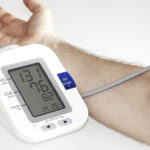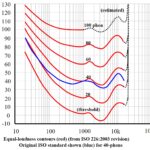Previous blogs have discussed human body pressures including blood pressure and optical pressures. However, there are several more pressure measurements for different body locations that need to be considered. For example, the pressures created by different situations on the human ear, and specifically the eardrum, are critically important. High noise environments such as industrial machinery and concerts are major concerns but explosions and barometric pressure extremes, such as underwater exploration, also are equally dangerous.
High noise environments
In ambient air, sound pressure is the local deviation caused by a sound wave. Sound pressure level (SPL), measured in decibels (dB), is equal to 20 x the Log10 of the ratio of the root mean square (RMS) of sound pressure to the reference of sound pressure. Note: the reference sound pressure in air is 2 x 10-5 N/m2, or 20 µPa. Sound level pressure measurements in air use an SPL meter that is often a handheld, mobile, and lightweight instrument manufactured to conform with international standards, such as IEC 61672.
Depending on where the observer is located and the duration of the sound, the noise levels that can occur in a factory or a loud concert can approach and possibly exceed what is called the threshold of pain. This value is typically in the range of 120-140 dB. A frequently cited high-level sound measurement associated with the threshold of pain is the noise from a jet engine for a close observer that is 120 dB.
However, a pressure differential across the eardrum (the tympanic membrane) of about 5 psi (35 kPa) can cause a rupture. While this pressure threshold varies for different individuals, at 14 psi (100 kPa) almost all eardrums will rupture.
Explosions
Injuries to the ears and hearing from the high-intensity noise in an explosion could include eardrum rupture, tinnitus, sensorineural hearing loss (nerve damage), hyperacusis (extreme sensitivity to noise), and balance disorders.
While explosions from dynamite and even firecrackers could result in serious hearing damage and even ultimately the total loss of hearing, another more likely explosion that many people could encounter occurs in a vehicle crash when the airbags are deployed. A car’s airbag inflation occurs in 0.05 seconds after the initial impact and deploys with a noise level up to 178 dB. One study found that up to 17% of the people involved in an airbag deployment could suffer hearing loss.
Underwater implications
While the pressurized cabins in modern aircraft have virtually eliminated the risk of ear barotrauma (pressure injury), other activities at barometric pressure extremes such as mountain climbing, skydiving, and especially scuba diving can pose serious problems. For example, scuba divers who do not adjust to the changes in pressure as they ascend can easily incur pressure differences that perforate their eardrums.
Other circumstances
Perhaps one of the more common occurrences in life that can potentially pose hearing problems is childbirth. During childbirth, closed-glottis pushing requires the mother-to-be to hold her breath and bear down forcefully while pushing during contractions. Since the glottis is the opening between the vocal cords in the throat, a pressure gradient occurs during this process similar to that registered during quick ascent in an unpressurized aircraft cabin. While this pressure has not specifically been measured, the average intra-abdominal pressure associated with the bearing down efforts of second-stage labor has been reported to be about 25 kPa. As mentioned previously, a pressure differential across the eardrum of about 5 psi (35 kPa) can cause a rupture.
References
What is Sound Pressure Level (SPL) and how is it measured?
Image source: https://pulsarinstruments.com/wp-content/uploads/2024/01/c-1b.jpg
IEC 61672-1:2013 Electroacoustics – Sound level meters – Part 1: Specifications
Occupant Detection and Sensing for Smarter Air Bag Systems (Progress in Technology) https://www.amazon.com/-/zh_TW/Randy-Frank/dp/0768013011
Airbags and Hearing Damage – Resonance Hearing Clinic




